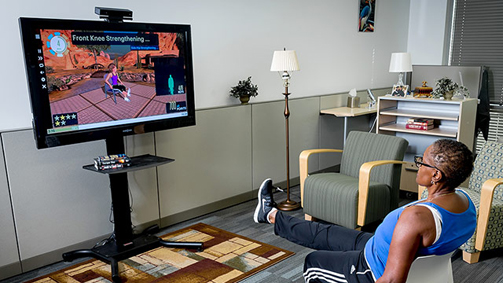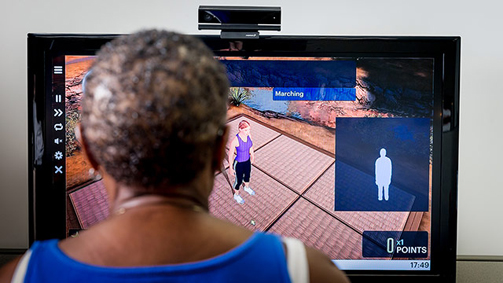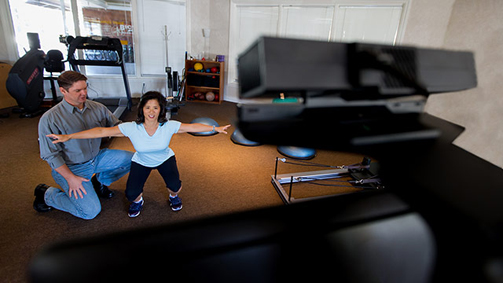Intel-GE Care Innovations uses Kinect solution to help elderly patients
“I’ve fallen … and I can’t get up.” That line, from a low-budget 1980s TV commercial hawking a personal medical emergency call button, has been fodder for countless comedians over the years. But falls among the elderly are anything but a laughing matter, especially to Maureen Glynn, the director of behavioral innovation programming at Intel-GE Care Innovations.
“Falls are a major health concern among the elderly,” she says, and the statistics certainly back her up. In fact, the U.S. Centers for Disease Control and Prevention reports that each year one of three Americans over the age of 65 takes a spill, and the results can be devastating: broken bones, permanent disabilities, and complications that can lead to death. In fact, falls are the leading cause of fatal and nonfatal injuries among older adults, with studies documenting that 20 to 30 percent of the elderly who fall suffer moderate to severe injuries. In 2003, for example, about 13,700 Americans 65 years or older died from falls, and another 1.8 million were treated in emergency departments for nonfatal fall injuries. Treating elderly patients who have fallen costs about $30 billion annually in the United States today, and experts estimate that that amount could more than double by 2020, given the aging population of Baby Boomers.

Under the watchful eye of the Kinect sensor, a patient performs her physical therapy regimen from
the comfort and convenience of her own home.
What’s more, once an elderly individual has suffered a fall, he or she is much more likely to fall again without some sort of intervention. “I had a 76-year-old family member who fell five times, enduring repeated broken bones,” Glynn recounts. And while broken bones are no fun for anyone, they pose special problems in the elderly, whose ability to heal is often diminished. Seniors who break a hip—a common injury in falls among the elderly—may end up spending considerable time in the hospital and rehab, and may never attain full functionality again. Such sufferers become physically inactive, which, notes Glynn “can lead to chronic mental and physical disease.”
Glynn’s employer is determined to change this dismal picture. As its name clearly indicates, Intel-GE Care Innovations is a joint venture of two industry titans. Founded in 2011, the company seeks to transform the way care is delivered by connecting patients in their homes with care teams—thus enabling patients to live independently whenever possible. Augmenting the technological strengths of its parent companies with deep knowledge of the healthcare system, Intel-GE Care Innovations collects, aggregates, and analyzes data to provide insights that connect providers, payers, caregivers, and consumers—and brings the care continuum into the patient’s home. For example, the company has established the Care Innovations Validation Institute to improve standards for measuring and promoting remote care management solutions and services.
One of the company’s latest products, RespondWell from Care Innovations, takes direct aim at the problem of falls among the elderly. As Glynn observes, “As a company dedicated to helping patients receive the healthcare they need while maintaining as much independence as possible, we saw the need for a home-based solution that helps older people recover from and avoid falls.”

The Kinect sensor monitors the patient’s performance, correcting improperly executed movements
and awarding points for those done appropriately.
Responding to this need led them to partner with RespondWell, a healthcare IT software company that, as CEO John Grispon explains, “specializes in activating patients and driving efficiencies. We motivate patients to follow through with their physical therapy, by making the activities interactive and engaging.” The company’s antecedents were in the gaming world, having created one of the first fitness games for the original Xbox, back in 2005. From there, RespondWell moved into the physical therapy industry, determined to do for rehab what they had done for fitness: getting people up and moving by making the often onerous rehab exercises interactive and entertaining.
Both Intel-GE Care Innovations and RespondWell saw Kinect as the logical platform for addressingfall prevention and rehabilitation among seniors. Recognizing how difficult it can be for older people to make daily visits to their therapist’s office, the teams at Intel-GE Care Innovations and RespondWell have created an interactive program that lets patients exercise in the comfort of their own home while providing Kinect-based gesture monitoring to ensure that they are performing their exercises correctly. The solution is sold to therapists and other healthcare providers.
It works like this: the therapist evaluates the patient and then designs a program of exercises that are intended to restore functions and, equally important, to prevent future falls. The patient learns the movements under the watchful eye of the therapist—and the unblinking lens of the Kinect sensor, which faithfully tracks the patient’s skeletal positions throughout the exercises.

Using data captured by the Kinect sensor, the physical therapist can track a patient’s progress and
adjust the exercise regimen as necessary.
At home, patients call up their personalized exercise program on a Windows tablet or PC, which is connected to a Kinect sensor. They then perform the exercises, again under the view of the Kinect sensor, and the system analyzes their movements and provides instructions to correct any mistakes. The system not only corrects errors, but it rewards good performance with points, adding a competitive element that many patients find highly motivating. Glynn praises this positive reinforcement element of the solution, pointing out that it motivates patients without being overly gamified. She also points out that the solution not only monitors and coaches patients in the comfort of their own home, but that it also sends data about the performance to their therapist, who can adjust the exercises as needed.
RespondWell from Care Innovations was developed on the Kinect v2 sensor, which Grispon enthusiastically endorses, “especially the enhanced field of view, which lets us get a good look at the patient even when he’s very close to the sensor.” He also praises the v2 sensor’s improved picture resolution and enhanced skeletal tracking, both of which boost the solution’s ability to precisely record patient movements. When asked how easy it was to port the code from the original Kinect sensor to the Kinect v2 sensor, Grispon quotes his lead developer, who says that the process was easy and offers this advice to other devs, “Smoothing is your friend—use it.” (Smoothing is a feature in SDK 2.0 that makes it easier for developers to recognize joints in the Kinect image.)
Currently in pilot testing, RespondWell from Care Innovations is expected to be generally available by January 2015. Patients in the pilot program report that the solution makes physical therapy more enjoyable, while therapists are delighted that patients are more motivated to do their home exercises and that they are performing them more accurately. Both Glynn and Grispon stress that RespondWell from Care Innovations fills a vital need in our healthcare system. A system that not only helps seniors recover from falls but also helps prevent future tumbles could curb medical costs and offer the elderly a much improved quality of life. We’re pleased that Kinect can play a role in this effort.
The Kinect for Windows Team
Key links
- Purchase the Kinect for Windows v2 sensor
- Download the free SDK 2.0
- See more photos of RespondWell from Care Innovations in use
- Learn more about health impact of falls among the elderly
- Discover the range of healthcare solutions from Intel-GE Care Innovations
- Explore the innovative patient engagement software of RespondWell